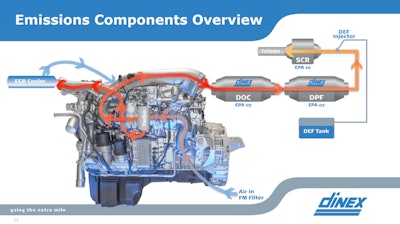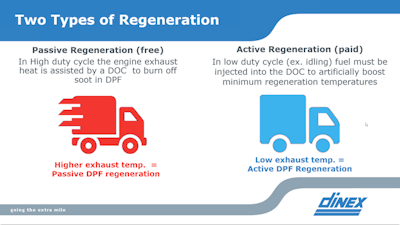Dinex Emission Aftermarket Sales Manager Sebastian Houde provided a whirlwind update on the components found in modern truck aftertreatment systems, how they function and their maintenance expectations Wednesday during GenNext’s first quarterly webinar of the year.
Houde says aftertreatment systems were first introduced in the North American truck market to meet the Environmental Protection Agency’s (EPA) 2004 regulations to reduce nitrogen oxide (NOx) emissions. EPA’s Phase I regulations were expanded in 2007 and 2010 as more stringent NOx and particulate matter emission rules were announced, with Phase II following last decade.

Houde says the EPA’s regulations have had a substantial impact on improving air quality nationwide. Additionally, after a tough start, he says today’s OEMs have developed incredibly advanced and intricate systems that enable medium- and heavy-duty trucks to “eliminate nearly 100 percent of NOx emissions and particulate matter.”
But to sell aftertreatment components in the aftermarket, one first must understand how the systems work. Houde says understanding aftertreatment starts with exhaust gas recirculation (EGR).
EGR systems were the first aftertreatment components introduced to the industry nearly two decades ago. These systems reduce the temperature within an engine’s combustion chamber, which helps the engine produces less NOx. Houde says one side effect of EGR systems is a rise in particulates — hotter exhaust is necessary to burn them down. He adds faltering EGR systems also can create downstream issues for other aftertreatment components.
The next component of note is the diesel oxidation catalyst (DOC). Houde says this component exists to inject heat into the emission system to burn off the soot and particulate that make it through the EGR.
After the DOC comes the diesel particulate filter (DPF), which traps particulates and is the most commonly serviced component in the emission system. Houde says DPF systems require more maintenance than other systems because of their task — they are the only components in the aftertreatment system that house particulate and trap harmful emissions.

The last substantial system in an aftertreatment system is the selective catalytic reduction (SCR) system. Houde says this system combines diesel exhaust fluid (DEF) — introduced between the DPF and SCR — with the remaining exhaust to create nitrogen and water vapor that can safely be released into the air.
These components represent a new but rapidly growing section of the aftermarket. Because of the EPA regulations required for emissions and the functionality of engine and aftertreatment systems, today’s commercial trucks cannot operate when any of these components are significantly malfunctioning. DPFs in particular are becoming a major service issue for fleets; a single DPF can only regen so many times before it must be removed and fully cleaned or replaced.
Houde advised the aftermarket attendees on Wednesday’s call to investigate these components if they have not already, and consider adding them to their product line. He says other than California, which requires direct OE genuine replacement parts for aftertreatment systems, every other state allows the sale of aftermarket emission components if the manufacturer is able to prove their component can provide OEM-level performance.











